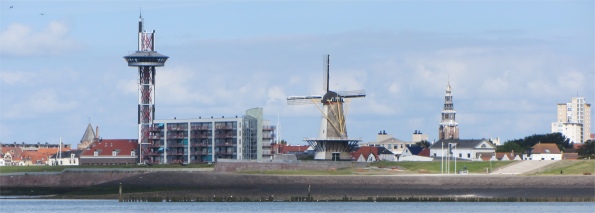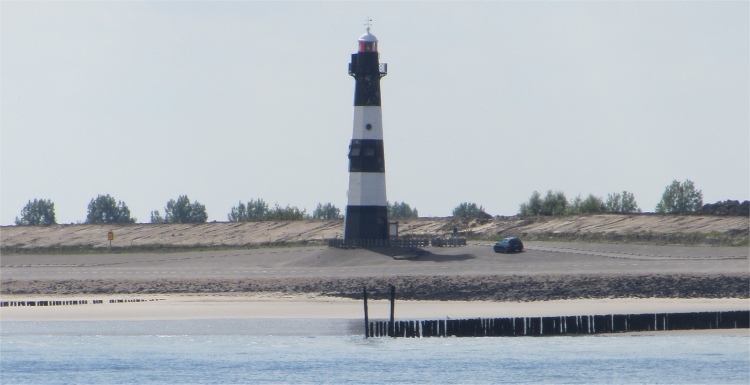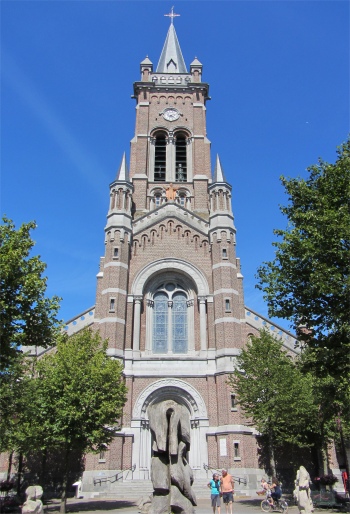
Saint Roch Church
|
We came across the Church of Saint Roch, a large church of brick exterior but fine, clean-lined stone inside. This Neo-Romanesque church, built to plans by architect Josef Hoste, was inaugurated in 1889. During its construction, Blankenberge was plagued by smallpox. When the population of Blankenberge turned to Saint Roch, who was called upon to fight the plague, recovery soon took place. This large church was an example of a seasonal church with valuable stained glass windows, and the texts refer to the generous donors, both local citizens and loyal holidaymakers. Apart from an old lady praying, we were the sole visitors.
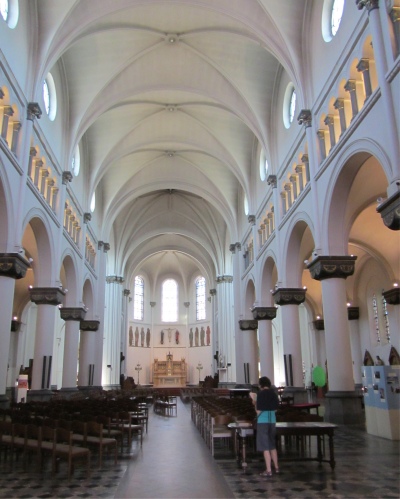
Clean Lines Inside St Roch
|
"Let's head down to Leopold III Plein," I said, expecting to find a grand square brimming with statues. It turned out to be a general tram interchange in front of the train station. It did have a tourist information centre where Rex found details of trams that could transport you all the way between Breskens (opposite Vlissingen) in the Netherlands, to past Dunkirk in France. This would be useful for crew getting around this coastline.
We had coffee in a square on Manitobaplein and engaged in that ancient activity of people watching. Rex's drink was unpalatable, and it took the staff a while to realise they had brought the wrong dishwater out for him to drink. It was all resolved in the end. "Nelson never had this trouble," I could hear him muttering. In a short space of time we observed the same woman cycling round a block and through the square three times. Then there was a young woman who also lapped three times through the square with her dog. Hmm.... another Belgian pastime, or was I missing something?
The market was not on today in the Grote Markt, but it did have a supermarket. We soon learned that all milk in Belgium contains added sugar. That explained some of the pear shapes then.
In the evening we enjoyed a pleasant meal whilst noting that a lot of the holidaymakers were taking quite young children out in the evening. Many of the poor kids were tired and grumpy, clearly wanting their beds.

Saint Roch Choir
|
We rounded off the day by walking down across the deserted, fine hourglass, cool sands to the firmer damp sand by the sea and watched the sun setting. Meryl was content to paddle in the icy waters. Rex and I were content to kick a big yellow buoy anchored to the shore. Each to his own.
We walked back via the Oude Haven, where we pondered for a while about the history of the harbour as we gazed upon some historic vessels.
For centuries, fishing was the most important source of livelihood in Blankenberge. At the end of the 13th century the fleet numbered more than 60 vessels. A protected jetty called "de kaeye vanden vierboete", was created in the 15th century. They switched to "small-scale fishing" in Blankenberge using the flat-bottomed barges that moored along the beach.
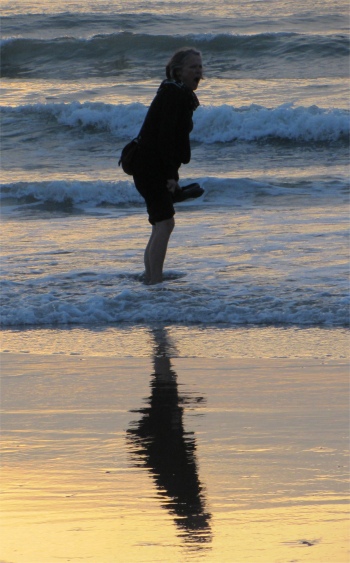
Ouch! That's Cold
|
Following the increase in the number of vessels - 16 barges in 1648, 30 barges in 1698, 50 barges in 1750 - calls went up in Blankenberge fishing circles for a sheltered harbour. From the end of the 17th century to the middle of the 19th century town councillors as well as the fishermen regularly called upon central government to build a harbour. Only in 1871 did the long cherished dream come true.
The harbour complex encompassed a harbour channel with a wooden jetty on each side, a sheltered harbour and a drainage basin. Sedimentation of the channel and harbour quickly led to a problem, particularly with respect to the last decade of the 19th century, when flat barges were replaced by keelboats with greater depth. Despite improvements, such as lengthening of the jetties and a sluice system in the eastern wharf wall, the harbour was unable to meet the requirements.
Shortly before World War I, the idea arose to fill in the existing harbour basin and to build a new harbour at the western harbour channel. That project was put on the table again in 1924 but was not implemented due to lack of funds.

Sint-Pieter
|
The fishing company in Blankenberge suffered a constant downturn between the two world wars. In 1925 the number of Blankenberge fishing vessels still amounted to 51. In 1939 this was reduced to 17. In June 1944 the Germans destroyed the harbour's entire infrastructure. The key question was whether or not the Blankenberge harbour should be kept. Eventually it was decided to maintain and restore the harbour but the fishing vessels that had been removed on orders of the occupier would not return, and the harbour company dwindled away completely. In the period between 1953-1954 several people proposed the switch to a marina. The former council also saw here a new future for the harbour and in the beginning of 1955 received permission to place the first harbour jetty. The harbour channel was dredged and on July 9th 1955 the marina of Blankenberge was inaugurated. The number of yachts rose sharply, new jetties were placed and the old harbour became saturated. In the second half of the 1960s the idea grew to turn the drainage basin into a marina. Work started at the end of the 1970s and in 1980 this new section of the marina was opened. The Blankenberge marina could now accommodate approximately 750 yachts. The most recent chapter of Blankenberge harbour history took place in the year 2000. A new extension of the marina was started that provided space to another 250 yachts. The marina's surroundings also underwent a facelift: the northern quayside (Barcadere) was renewed, the small peninsula near the fishing market disappeared, a new footpath was constructed and the Franchommelaan was constructed. The expanded marina, with enough space to accommodate approximately 1000 yachts, was officially opened in 2004.
Below in the Oude Haven, the Blankenberge maritime fleet still contained some remnants from its fishing history; The shrimp boat
Jacqueline-Denise was a wooden vessel that was built in the shipyard of Borrey in Ostend. Although the laying of the keel took place in 1939, the ship was not complete until 1942. The shrimp boat remained in the trade until 1951 and was one of the few remaining vessels from this period. The
Jacqueline-Denise was a typical fishing vessel from between the two world wars. The type symbolised the transition from sea fishing with sails to motorised vessels.
The Blankenberge flat-bottomed barge had been around in the 16th century. These flat-bottomed vessels were approximately 11m long and 5m in width with the average tonnage amounting to 20 tons. Characteristic of the Blankenberge barge was the two fusible rigged masts, the quite round bow and the two lee boards on both port and starboard sides. The crew consisted of 5 persons: the captain, three shipmates and the apprentice. The last Blankenberge barge was launched in 1904 and with the arrival of the Great War, the remaining barges disappeared. A century later a group of enthusiasts from various circles built a replica of a Blankenberge barge: the
Sint-Pieter.
Also contained in the collection was a replica of a 19th century pilot cutter; 16m long, 4.6m wide and a draft of 2.8m. The pilot cutter accommodated 10 crewmembers and could handle great distances. Cutters were built from the 17th to the 19th century in neighbouring countries, and were highly manoeuvrable.
3rd July
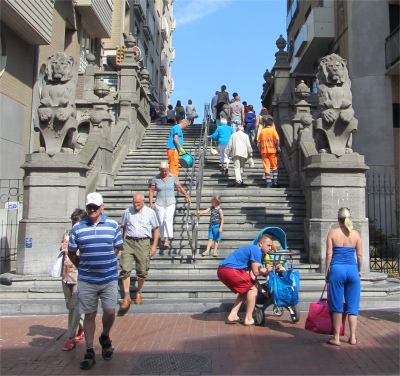
Old Steps over the Dyke to the Blankenberge Beach
|
Another blisteringly hot day seemed to be in the offing. After breakfast I walked into town to buy a present for my grandson.
The pedestrianised Kerkstraat was awash with a tide of people heading towards the beach; it was a struggle trying to get through it. The folk had all alighted from trains and trams at Leopold III Plein, and were obviously treading the most direct route.
In the midst of the tangle of shops I stumbled across a small, old building. There was no indication what it was, just a small circular blue label attached to the building declaring it to be a monument. I later learned it was the "Oude Stadhuis". What a shame that nothing much was made of this historic building, no placard, sign or anything.
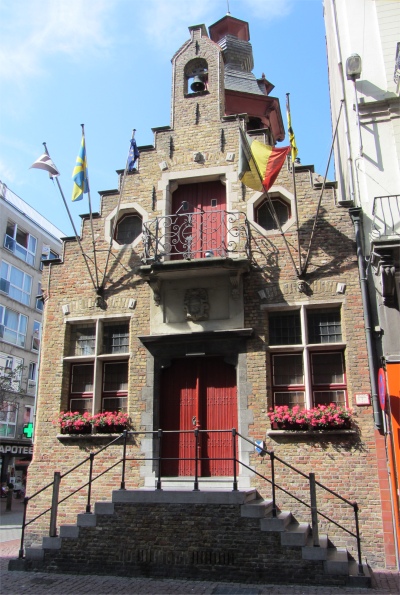
Oude Stadhuis
|
Walking down a side street I came across another small circular blue label declaring a monument. Beside it was an arched walkway, perhaps the monument was down there, so being curious I walked through into a beautiful sunlit courtyard full of tables populated by the tea and coffee drinking society. In the centre of the courtyard stood an old red-brick, single storey building that was probably a church at one time. Sadly there was nothing there to tell the story, and the building was locked up.
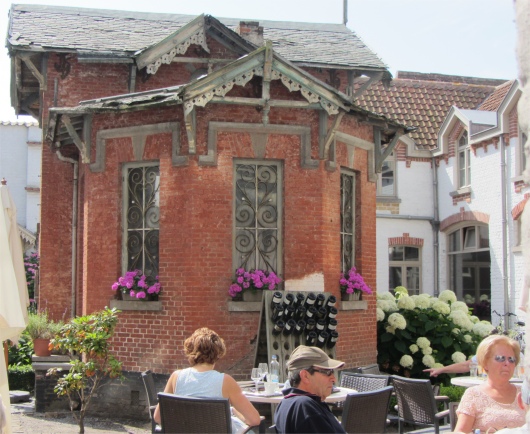
Unknown Monument in the Courtyard
|
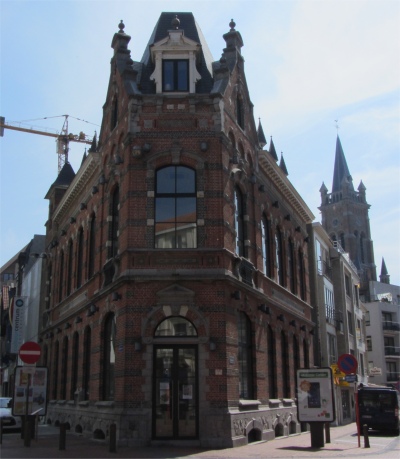
Cultural Building
|
The Cultural Centre, a striking building on a triangular footprint like the flat-iron buildings I had seen in San Francisco, contained an exhibition on Blankenberge during the First World War; a collection of photographs with some memorabilia. Sadly all the text was in Flemish, but I gleaned from it that the town had a pretty Victorian/Georgian style frontage at one time. Photographs showed German occupying troops marching up and down the promenade, playing football on the beach, and engaged in barrel rolling competitions. A lot of destruction took place during that war. I wondered how much destruction had occurred during the Second World War. Perhaps these were the reasons why so few heritage buildings remained in the town. Those that did survive seemed to have blended into invisibility of the modern development of shops, businesses and residential properties. Maybe the town council put development higher on their list of priorities than heritage, but still, why not show off what they did have instead of letting it slide into obscurity.
After topping up with diesel, we travelled a mile or so off shore before turning down the coast. In glorious sunshine, we sailed carefree down to Ostend, and very enjoyable it was too. Our resting place was the RYCO Jachthaven marina deep in the heart of the dock complex. A cheery harbour master helped us with our ropes, and responded well to Rex's French conversation, even though the language spoken in these parts was Flemish. Rex just couldn't resist demonstrating his multilingual skills.
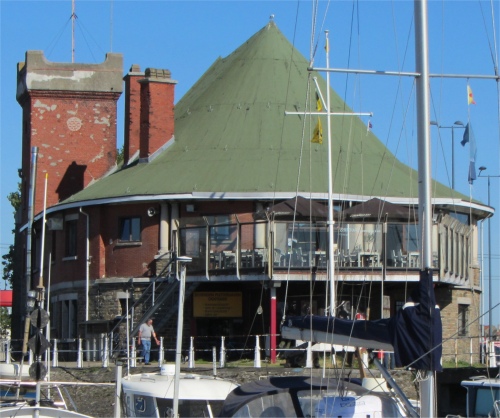
RYCO Jachthaven Clubhouse
|
As we were sorting ourselves out, a large motorised boat shuddered alongside the long pontoon adjacent to us. On its stern, a dear, old lady was heaving a heavy rope. I took the line from her and secured it around a bollard, and Rex helped out at the bows. Once secured, we engaged in a chat with the old couple on the craft. They had just travelled up from Dunkirk. Their sturdy craft had no home port, the couple travelled around a lot and just left the boat where it was when winter deterred them from sailing. The previous two winters the boat was moored up in Finland and Sweden. The couple were getting on in years, and perhaps the boat was becoming too much for them. Indeed, the old lady seemed to be in a tearful state when they arrived at the pontoon. We didn't ask.
Half an hour later a large, powerful hydrofoil berthed onto the same pontoon, closely followed by another. These formidable craft had their home port emblazoned across their sterns - Middlesborough. Were the Belgians buying British boats nowadays? I heard shouts from one boat to the other, dulcet Geordie tones, and I knew they were from and manned by lads from the northeast of England. One of the chaps strolled over to study the old couple's boat, so I wandered over to have a chat with him in a common tongue. He was clearly fascinated by the sturdy boat. "Converted Orkney Class lifeboat," he told me. Now I realised why the lines of the boat seemed familiar to me, not that I could tell one class of lifeboat from another.
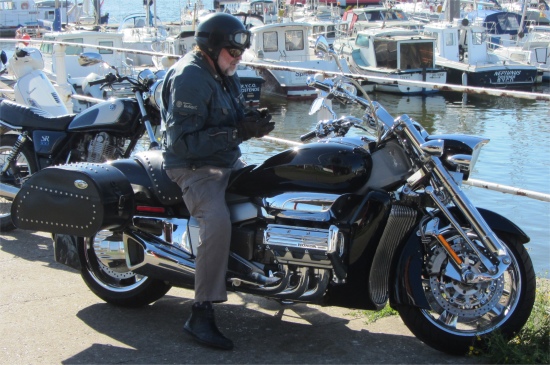
Little Old Man and his Motorbike
|
The chap came from Seahouses in Northumbria. The two boats that he arrived with were part of a fleet of boats that had a contract for servicing one of the large wind turbine farms some 26 miles north of Ostend. I learned that if the swell at the turbine masts rose and fell by three rungs or more (about a metre), the boat would not land or collect anyone from the turbines. Today they had not landed anybody, and was spent fishing. Their contract would expire in a month, and they would move on to another wind farm off Kent.
I watched an old man pull up on his huge Honda motorbike. He was small and it seemed as if he would have to lie almost horizontally across the fuel tank to reach the handlebars. He parked his bike by the marina clubhouse, and lovingly covered it with a tarpaulin before ambling off down the gangplank.
With the sun setting, but still emitting scorching heat, we ate in the pretty clubhouse that overlooked the marina and dock complex; a lovely ending to the day.

